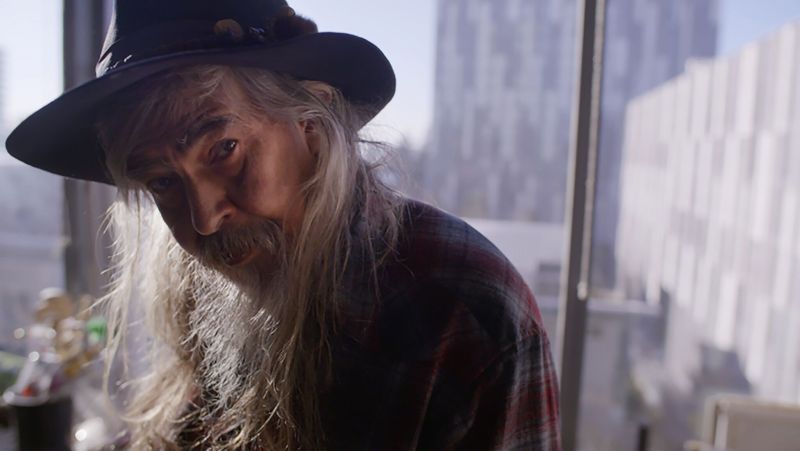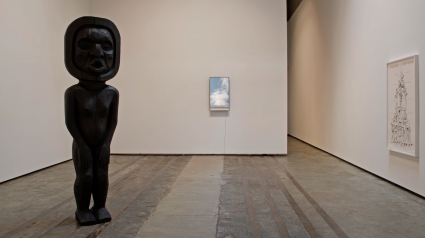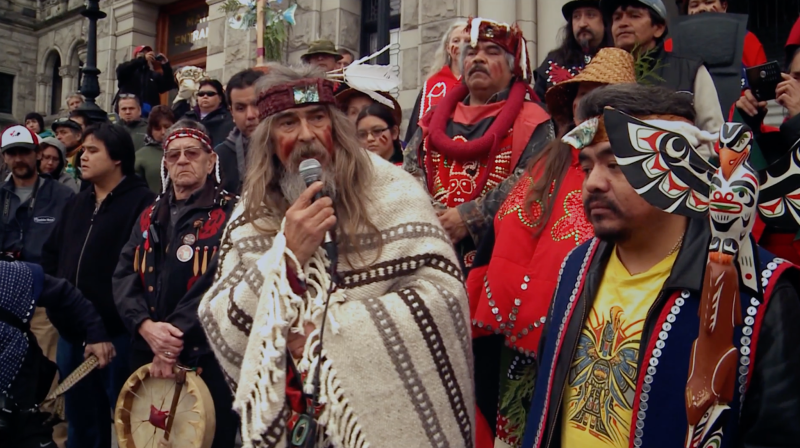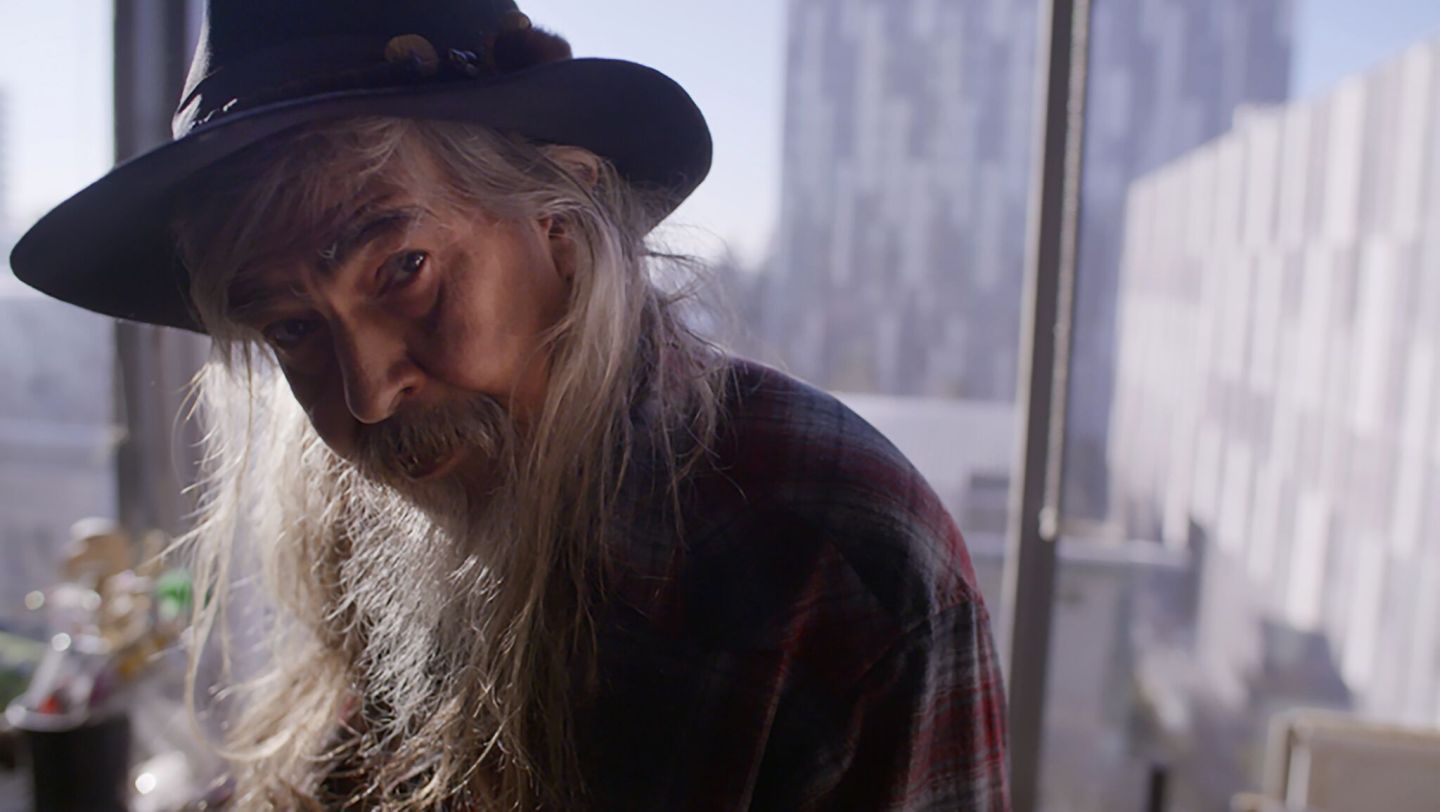Interview with LaTiesha Ti’si’tla Fazakas and Natalie Boll
By Anya Zoledziowski
This film is part of the annual #mustseeBC filmmaker showcase presented by STORYHIVE, now open until September 28th. Visit mustseebc.viff.org/ for more details and to vote for Meet Beau Dick: Maker of Monsters.
When LaTiesha Ti’si’tla Fazakas is asked to describe her partnership with Natalie Boll — a partnership which led to the production of their film Meet Beau Dick: Maker of Monsters — she needs only one word: serendipitous.
“I feel like we were meant to come together for this project,” says Fazakas, who has spent her professional life working in galleries and curating art. Even Boll, a seasoned filmmaker who originally expressed hesitation about adding this film to her loaded list of to-dos, changed her tune when she met Fazakas and saw a mask carved by Kwakwaka’wakw artist Beau Dick. “I came to [Fazakas’s] house and she took me down these stairs, and there was a huge mask of Beau, and shivers ran down me,” explains Boll. “I’ve never seen something so powerful in my life.”
Shortly thereafter, the two made it their mission to introduce Beau Dick to the world through film. Now, after about half a decade of filming, they’ll acquaint their audience with the man behind the mask through the Vancouver International Film Festival’s Sea to Sky program stream. In anticipation of their documentary, I spoke with Fazakas and Boll about the obstacles they encountered during production, their protagonist, and what their film represents now that Beau Dick has passed away.
Anya Zoledziowski: Give me an idea of what sort of processes you had to go through in order to produce the film.
Natalie Boll: We never ended up getting funding, grants, or backing on the film. Initially,when I met LaTiesha, she had been developing it independently. And when we came together, we were initially looking at broadcasters, or grants, or somebody to come  on board with us. But we realized that the story couldn’t be conformed to what a lot of the networks were asking. You know, “What is your teaser?” and “What is the climax?” and all of these contrived notions, when we really realized we wanted to follow Beau authentically. The project didn’t work within those confined constraints. In a way, it was a blessing that we didn’t have any of the constraints by funding, or networks giving us a timeline, because normally they’ll be like, “Oh, you need to deliver within a year.” We would have never gotten a full story if we had stopped filming; it organically came to an end.
on board with us. But we realized that the story couldn’t be conformed to what a lot of the networks were asking. You know, “What is your teaser?” and “What is the climax?” and all of these contrived notions, when we really realized we wanted to follow Beau authentically. The project didn’t work within those confined constraints. In a way, it was a blessing that we didn’t have any of the constraints by funding, or networks giving us a timeline, because normally they’ll be like, “Oh, you need to deliver within a year.” We would have never gotten a full story if we had stopped filming; it organically came to an end.
LaTiesha Fazakas: Yeah, I think it’s very unique, too, that you have two people who both have a very distinct kind of style and creativity, but we were always on the same page. Which I thought was really quite remarkable about this project. And organic. “Organically” is kind of the foundation of the project; it developed itself. We really worked at being open and really listening to what direction it was going to go. One of the challenges was that we were not Native and Beau was Native. And so, we as filmmakers can only go to non-Native funding, and non-Native funding didn’t want to fund a Native project.
Zoledziowski: So, tell me a little bit about Beau Dick, who is he?
Fazakas: Well, I think the best way to tell you about Beau is [for you] to watch the film. But I think Beau really was, and still is, a little bit magical. He was somebody who was charismatic and also a bit of an anomaly. He was very special. And he wasn’t perfect, he had lots of flaws, but there was something so special about him, and they just made him that much more special.
Zoledziowski: What inspired you to produce a film about him?
Fazakas: Well, I first encountered Beau about 20 years ago. At the time I was working in a traditional Native Art gallery, and there was a closet full of masks from different artists. I just started working there, I had a degree in western art history from UBC, and I had taken one course on Northwest Coast art, but I wasn’t really all that familiar with the aesthetics, so I felt very out of my range when I first started there. I couldn’t really connect with any of the work at first. And when I opened the closet, and there must have  been at least 50 masks in there from most of the top artists working on the Coast, immediately, I gravitated towards the Beau Dick mask. I picked it up and I had this incredibly overwhelming feeling, and I looked at my co-workers and said, “Who is this? This I get.”
been at least 50 masks in there from most of the top artists working on the Coast, immediately, I gravitated towards the Beau Dick mask. I picked it up and I had this incredibly overwhelming feeling, and I looked at my co-workers and said, “Who is this? This I get.”
The thing that transcends culture is emotion. We all feel emotion, and you could not encounter one of his pieces and not have some sort of emotional reaction. So, when they said, “Well this is Beau Dick,” immediately, I was like, “How do I not know this guy already? How is he already not the most famous person in the world?” And that ignited a passion in me for Beau and for his work. I felt, throughout the years, moving forward from there, that he was always marginalized. And it was at a time when there were not very many, if any, Native artists in the mainstream in the western contemporary art world. I felt very passionately that he was marginalized, and from then on, I really wanted to promote his work, and him as an artist, and his career.
Zoledziowski: Has his passing changed the way you two view the film’s significance?
Boll: We really came into this going “Everyone needs to meet Beau Dick,” which is what LaTiesha first said to me when I came on board. And I feel how blessed we are to be able to have this film so we can achieve that goal of really bringing his messages out, showing his art, showing him and the people that surround him. Because it really became not just about him personally, but the world that he was in, and who he shared it with. And really, what LaTiesha just talked about — the messages that he was bringing forward. So, I think people might not be able to physically meet him now, but his art lives on and that’s something he touched upon in the film: his art will outlive him. But I want his message to continue forward and I think that’s really important.
Zoledziowski: LaTeisha, you’ve known Beau for decades, and in a statement about him, you said, “His influence was a profound directional force for me both personally and professionally.” Can you elaborate on that?
Fazakas: I apparently became a film director and producer because of Beau, so that’s kind of huge. Beau was the reason I started my gallery, and that I took the chance on doing that. That was a really big leap for me to open up my own gallery. And so, the gallery and the film are two ways in which he, and just being part of his life, moved me in a new direction professionally.
And then personally, through knowing him, I found out so much that I didn’t know about Canada and our history, and I became part of a community. That’s one thing that, if you spend enough time with Beau, you end up kind of becoming part of the community. His Aunt Doreen passed on her hereditary potlatch name to me, which is the middle name that I use in my name, which is Ti’si’tla.
Zoledziowski: You produced this film here in BC. What role did the local aspect play throughout the production process?
Boll: What was really beautiful about this film, which I found more than any other project that I’ve ever worked on, was how inspired everybody was to help. And how much of a community we had putting this together. Like it really was a collaboration. So, throughout the film we had different friends helping, whether it was coordinating, whether it was helping us put together release forms, whether it was coming out with our camera for events. But I never had anybody say, “No, I don’t want to help you.” Anytime we had something and we mentioned it, we didn’t even have to ask, we had people joining, helping, totally inspired to help. And I think that was the magic of Beau as well, people were really inspired by him and intrigued by him, and he had this energy that people just really connected to. So, being in Vancouver was very logistically awesome.
It was a little bit more difficult with Alert Bay because it was quite a trek, and even if everybody is volunteering to go, you need accommodation. It’s hard to get food on the island, so you need to bring stuff. You’re very limited, and it takes two ferries and a long drive to get there. So, even if you’re doing the bare minimum, it’s a lot of money to bring a van over with a crew. Paying for all of that, it is quite expensive to go there.
Zoledziowski: What do you hope your audience ultimately takes away from the film?
Boll: Knowing who Beau is, and his artwork, and understanding the importance of that. Really starting a conversation. And I think that’s what was so amazing about Beau, is that he looked at things in such a different way, that he invoked in me, and other people that I know, the reaction of questioning the norm. And questioning why things are the way they are. [The film is] a lot about Beau; I want people to meet Beau and understand him. But within that, it’s the message, and continuing those conversations and stories that we discuss in the film, and just keeping those issues alive.
Fazakas: I think for me it starts with the idea that First Nations issues are all of our issues. Beau says that in the film, and I really hope that, because he’s so emblematic of all of these things, and he’s so beguiling, that we entice people to be open to the possibility that the way that they think about First Nations issues and environmental issues can perhaps change.
Zoledziowski: I’ve got to say, it’s so cool to talk to two female filmmakers who worked together — it’s still a tough industry for women. But is there anything I may have missed that either one of you would like to touch on?
Fazakas: I think the last thing that you said about two women. I think it’s one of the things that I hope gets to be part of the discussion about this film. I hope that the message that women can successfully work together beautifully and collaboratively, rather than competitively, comes out of this. Because we really created a beautiful partnership. And you know, we relatively didn’t know each other that well before this started. And we became friends, and then we became project partners, and I hope that other people see this as an example of what is possible.
Boll: I think LaTiesha said it perfectly. I think another thing that really inspired me after this whole process is also the art side, which LaTiesha has way more knowledge on. But, it changed the way I look at Northwest Coast art, because I realized that each piece, you’re intrigued by it. There’s so much history behind it, there’s so much meaning behind it, and you can feel it. But now, knowing that when I look at [Northwest Coast art], whether it’s a totem, whether it’s a mask, really learning what’s behind it and who is behind it. And that to me is really exciting because I lived around Northwest Coast art my whole life. When you live in Vancouver, you have it at the airport, you have it everywhere you encounter these beautiful pieces. I’m hoping the film also inspires people to want to know more about the art that we see across B.C. and across Canada, and really knowing the history and what’s behind it.
Meet Beau Dick: Maker of Monsters is screening at the Vancouver International Film Festival as part of the SEA TO SKY program stream on Sunday, September 30 and again Wednesday, October 11. Tickets available here.
This interview was edited for length and clarity.
